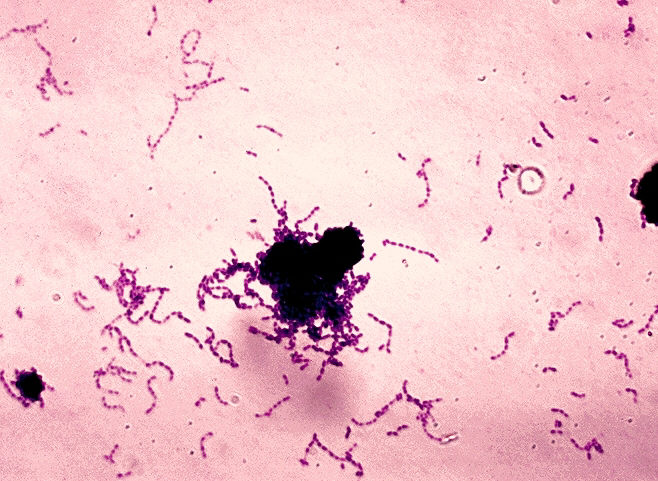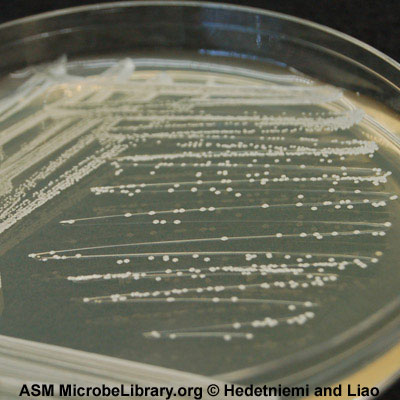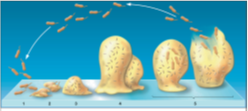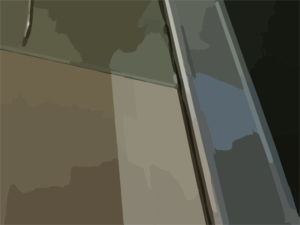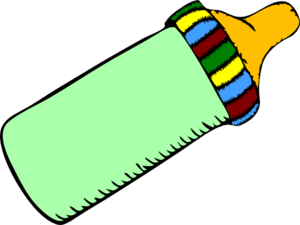Microbewiki:''Streptoccus mutans'' and Dental Caries
PROFILES IN BACTERIOLOGY:
What is Streptococcus mutans?
Gram Stain of Streptoccus mutans. CDC/Dr. Richard Facklam. 1975.
Streptococcus mutans is a Gram positive streptococcus bacterium that inhabits human teeth and has been demonstrated to be the primary bacterial cause of dental caries (commonly known as cavities). S. mutans is often part of the normal flora or normal microbiota of humans, so the presence of S. mutans in the mouth does not automatically cause dental caries. However, S. mutans can be transmitted among humans, so caries is classified as an infectious disease.
Here is a culture of Streptococcus mutans grown in the laboratory:
LA plate streaked with Streptococcus mutans and incubated at 37ºC for 24 hours
Want to know more about how S. mutans causes cavities? See the S. mutans and dental caries section.
References:
- Image 1043, Public Health Image Library. CDC website.
http://phil.cdc.gov/phil/details.asp?pid=1043
- Tortora, G. J., Funke, B. R., and Case, C. L. Microbiology: An Introduction, Tenth edition. 2010 Pearson Education, Inc.
Classification
Streptoccus mutans is a gram-positive spherical (coccus) bacterium that occurs in chains (strepto-).
- Domain: Bacteria
- Phylum: Firmicutes (low G-C, Gram + bacteria)
- Class: Bacilli
- Order: Lactobacillales
- Family:Streptococcaceae
- Genus: Streptococcus
- Species: Streptococcus mutans
Notes:
- viridans streptococci
The Streptococcus genus includes a group called the viridans streptococci, to which Streptococcus mutans belongs. The viridans streptococci were originally believed to be one species and were identified by the green color they produced on blood agar, which indicates alpha-hemolysis (partial lysis of the red blood cells). Unfortunately, not all bacteria classified as viridans streptococci exhibit alpha-hemolysis, so the viridans classification can be a misnomer.
- mutans streptococci
Additionally, it is important to note that the mutans streptococci form a group of oral streptococci that includes Streptococcus mutans. The single species Streptococcus mutans was named after it was realized that the mutans streptococci consisted of more than one species.
References:
- Allmann, Amber. Streptococcus mutans. Wiki.
http://bioweb.uwlax.edu/bio203/s2007/allmann_ambe/
- Image 1043, Public Health Image Library. CDC website.
http://phil.cdc.gov/phil/details.asp?pid=1043. Accessed 16 May 2013.
- “Streptococci and Oral Streptococci”. School of Dental Sciences, Newcastle University, Newcastle upon Tyne. www.ncl.ac.uk/dental/oralbiol/oralenv/tutorials/. Accessed 16 May 2013.
- Tortora, G. J., Funke, B. R., and Case, C. L. Microbiology: An Introduction, Tenth edition. 2010 Pearson Education, Inc. p. 319.
Streptococcus mutans and dental caries
h3 What are dental caries?
- dental caries areas of decay brought on by bacterial infections of the teeth
- dental caries are considered to be an infectious disease[1]
Open content from WikiEducator.org
This figure shows the progression of dental caries from affecting only the outer surface of the tooth (enamel caries) to more advanced forms of decay in which inner tooth structures are also affected. Different species of bacteria are involved in these stages of dental caries. Streptoccus mutans is associated with the early stage, enamel caries.
h3 How do caries form?
- Streptococcus mutans exist as part of the normal flora of the mouth
- S. mutans adhere to the teeth as part of a [biofilm]
- other species of bacteria join this mass of S. mutans bacteria on the teeth
- Actinomyces attaches by extensions called fimbriae to the dextran (a sugar) that S. mutans secretes
- S. mutans metabolizes sucrose (table sugar) and secretes lactic acid as a byproduct
- lactic acid can demineralize the teeth, leading to indentations in the enamel that are called cavities
- S. mutans is involved in enamel caries, but other bacteria are more abundant in later stages of caries
References:
- Oral Health in America: A Report of the Surgeon General. Ch. 3: Dental and Periodontal Infections.
http://www.nidcr.nih.gov/datastatistics/surgeongeneral/sgr/chap3.htm
- Tortora, G. J., Funke, B. R., and Case, C. L. Microbiology: An Introduction, Tenth edition. 2010 Pearson Education, Inc. p. 81, 163, 431, 707-708
Biofilms
What is a biofilm?
- a coating (film) of bacteria (bio) that adhere to one another and to a surface
- Biofilms are made up of the bacteria (or other microbes) and also a matrix of sugars and other polymeric substances that connect the cells to one another.
Figure adapted from "Biofilms and Biocomplexity." Karin Sauer, Alex. H. Rickard, and David G. Davies. The biofilm developmental process in stages. (1) reversible attachment, (2) irreversible attachment, (3 & 4) maturation and (5) dispersion.
Bacteria in biofilms communicate and form pillars so that water and nutrients can flow past each of them.
Some common biofilms:
- dental plaque
- shower scum
- algae on swimming pool walls
Why do biofilms matter?
Biofilms are stubborn against techniques like brushing and even antibiotics or disinfectants, so dental plaque will still build up even if a person does brush his teeth. This is why regular cleanings are important: the tools the hygienist uses can help to remove the plaque from teeth.
References:
- Marsh, P.D. "Dental Plaque as a Microbial Biofilm." Caries Research. 2004.
- Sauer, K., Rickard, A. H., and Davies, D.G. "Biofilms and Biocomplexity." Microbe, 2007, 2:7, p. 350.
- Tortora, G. J., Funke, B. R., and Case, C. L. Microbiology: An Introduction, Tenth edition. 2010 Pearson Education, Inc. p. 81, 163, 431, 707-708
Early Childhood Caries (ECC)
- Early Childhood Caries, also known as ECC, is defined by the American Dental Association as a condition of currently decayed teeth, teeth that are missing due to caries, or fillings for caries occurring in a child between 0 years and just under 6 years old (71 months).
- One major risk factor for the development of early childhood caries is the continual intake of sugary drinks from baby bottles. Dentists generally recommend that children not be sent to bed with a bottle because of this risk.
- The effects of ECC may be more severe than the effects of adult caries.
- ECC tends to occur in higher rates among "disadvantaged populations."
- In the United States, Alaskan native and American Indian populations are one group that experiences a higher than normal prevalence of ECC.
References:
- de Silva-Sanigorski1, A. M., Calache, H., Gussy, M., Dashper, S., Gibson, J., Waters, E. "The VicGeneration Study: A Birth Cohort to Examine the Environmental, Behavioural and Biological Predictors of Early Childhood Caries: Background, Aims and Methods." BMC Public Health, 2010, 10:97.
http://www.biomedcentral.com/1471-2458/10/97
- "Statement on Early Childhood Caries." American Dental Association.
- "2010 Symposium on Early Childhood Caries in American Indian and Alaska Native Children." Council on Access, Prevention and Interprofessional Relations. American Dental Association, 2011.
http://www.ada.org/sections/professionalResources/pdfs/2010_ecc_symposium_report.pdf
References
Chockalingam, Evvie, and S. Subramanian. “Utility of Eucalyptus Tereticornis (Smith) Bark and Desulfotomaculum Nigrificans for the Remediation of Acid Mine Drainage.” Bioresource Technology 100, no. 2 (January 2009): 615–621. doi:10.1016/j.biortech.2008.07.004.
“Genus Desulfotomaculum - Hierarchy - The Taxonomicon.” Accessed November 5, 2013. http://taxonomicon.taxonomy.nl/TaxonTree.aspx?id=229.
Kaksonen, Anna H., Stefan Spring, Peter Schumann, Reiner M. Kroppenstedt, and Jaakko A. Puhakka. “Desulfotomaculum Thermosubterraneum Sp. Nov., a Thermophilic Sulfate-reducer Isolated from an Underground Mine Located in a Geothermally Active Area.” International Journal of Systematic and Evolutionary Microbiology 56, no. 11 (November 1, 2006): 2603–2608. doi:10.1099/ijs.0.64439-0.
Liu, Yitai, Tim M. Karnauchow, Ken F. Jarrell, David L. Balkwill, Gwendolyn R. Drake, David Ringelberg, Ronald Clarno, and David R. Boone. “Description of Two New Thermophilic Desulfotomaculum Spp., Desulfotomaculum Putei Sp. Nov., from a Deep Terrestrial Subsurface, and Desulfotomaculum Luciae Sp. Nov., from a Hot Spring.” International Journal of Systematic Bacteriology 47, no. 3 (July 1, 1997): 615–621. doi:10.1099/00207713-47-3-615.
Moser, Duane P, Thomas M Gihring, Fred J Brockman, James K Fredrickson, David L Balkwill, Michael E Dollhopf, Barbara Sherwood Lollar, et al. “Desulfotomaculum and Methanobacterium Spp. Dominate a 4- to 5-kilometer-deep Fault.” Applied and Environmental Microbiology 71, no. 12 (December 2005): 8773–8783. doi:10.1128/AEM.71.12.8773-8783.2005.
Ogg, Christopher D, and Bharat K C Patel. “Desulfotomaculum Varum Sp. Nov., a Moderately Thermophilic Sulfate-reducing Bacterium Isolated from a Microbial Mat Colonizing a Great Artesian Basin Bore Well Runoff Channel.” 3 Biotech 1, no. 3 (October 2011): 139–149. doi:10.1007/s13205-011-0017-5.
Pikuta, E, A Lysenko, N Suzina, G Osipov, B Kuznetsov, T Tourova, V Akimenko, and K Laurinavichius. “Desulfotomaculum Alkaliphilum Sp. Nov., a New Alkaliphilic, Moderately Thermophilic, Sulfate-reducing Bacterium.” International Journal of Systematic and Evolutionary Microbiology 50 Pt 1 (January 2000): 25–33.
- Allmann, Amber. Streptococcus mutans. Wiki.
http://bioweb.uwlax.edu/bio203/s2007/allmann_ambe/. Accessed 16 May 2013.
- de Silva-Sanigorski1, A. M., Calache, H., Gussy, M., Dashper, S., Gibson, J., Waters, E. "The VicGeneration Study: A Birth Cohort to Examine the Environmental, Behavioural and Biological Predictors of Early Childhood Caries: Background, Aims and Methods." BMC Public Health, 2010, 10:97.
http://www.biomedcentral.com/1471-2458/10/97. Accessed 16 May 2013.
- Facklam, R. Image 1043, Gram Stain of Streptococcus mutans. Public Health Image Library, Center for Disease Control website, 1975. http://phil.cdc.gov/phil/details.asp?pid=1043. Accessed 16 May 2013.
- Forssten, S., Björklund, M., and Ouwehand, A. C. "Streptococcus mutans, Caries and Simulation Models." Nutrients 2010, 2, 290-298.
- Hedetniemi, Kevin and M-K, Liao. 2006. Luria Broth (LB) and Luria Agar (LA) Media and Their Uses: Streptococcus mutans. Furman University, Greenville, SC. http://www.microbelibrary.org/index2.php?option=com_resource&controller=article&Itemid=73&article=3033. Accessed 25 April 2013.
- Marsh, P.D. "Dental Plaque as a Microbial Biofilm." Caries Research. 2004.
- Oral Health in America: A Report of the Surgeon General. National Institute for Dental and Craniofacial Research. Ch. 3: Dental and Periodontal Infections.
http://www.nidcr.nih.gov/datastatistics/surgeongeneral/sgr/chap3.htm. Accessed 25 February 2013.
- Sauer, K., Rickard, A. H., and Davies, D.G. "Biofilms and Biocomplexity." Microbe, 2007, 2:7, p. 350.
http://www.microbemagazine.org/images/stories/arch2007/july07/znw00707000347.pdf. Accessed 3 April 2013.
- "Statement on Early Childhood Caries." American Dental Association.
http://www.ada.org/2057.aspx. Accessed 16 May 2013.
- “Streptococci and Oral Streptococci”. School of Dental Sciences, Newcastle University, Newcastle upon Tyne. www.ncl.ac.uk/dental/oralbiol/oralenv/tutorials/. Accessed 16 May 2013.
- "2010 Symposium on Early Childhood Caries in American Indian and Alaska Native Children." Council on Access, Prevention and Interprofessional Relations. American Dental Association, 2011.
http://www.ada.org/sections/professionalResources/pdfs/2010_ecc_symposium_report.pdf. Accessed 25 March 2013.
- Tortora, G. J., Funke, B. R., and Case, C. L. Microbiology: An Introduction, Tenth edition. 2010 Pearson Education, Inc. p. 81, 163, 319, 431, 707-708.
